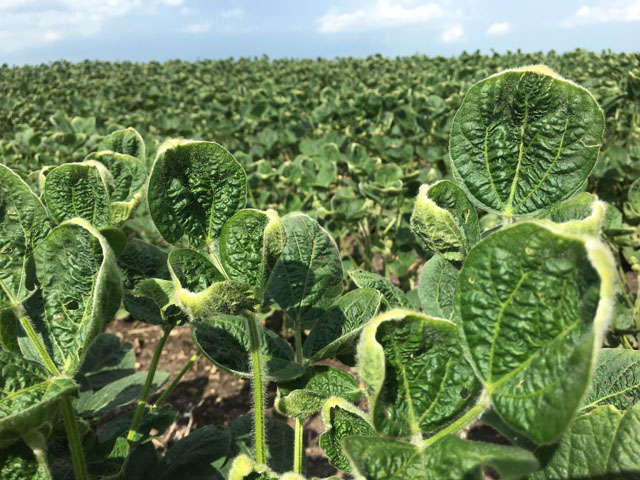Nearly 3,500 Dicamba Reports
EPA Reports Dicamba Off-Target Incidents Sharply Increased Since 2016
LINCOLN, Neb. (DTN) -- The EPA said in its dicamba draft risk assessment released on Thursday that the agency continues to struggle to get a grasp on how common off-target incidents of the herbicide has become.
EPA said in the 287-page draft risk assessment that in 2021 the agency received nearly 3,500 incident reports not already reported as part of the Incident Data System. Those included damage to non-dicamba-tolerant soybean, "numerous other crops," as well as to a wide variety of non-target plants in non-crop areas including residences, parks and wildlife refuges.
"Incidents reported for the 2021 season provide a snapshot of potential damage caused by product use, but the number of reported incidents is generally expected to underrepresent the actual number of incidents," EPA stated.
Among the findings of the draft assessment, EPA said it found no evidence new measures put in place in October 2020 for over-the-top applications helped reduce the number of off-target incidents.
DTN has documented issues with off-target dicamba movement through several stories, webinars and discussions leading up to the over-the-top registration in 2016 and through the 2022 season.
The agency also offers data on how the nature of incident reports have changed since EPA approved over-the-top use of dicamba on DT plants. Prior to that approval for cotton and soybeans for the 2017 growing season, the EPA said it received reports to the IDS of about 11,800 incidents from 1981 to 2016 -- or an average of 337 reports annually.
"Until recently, localized small-scale residential uses (e.g., lawn care products) have accounted for most alleged incidents whereas the number of wide area damage (i.e., landscape level) incidents associated with crops has increased in recent years, specifically since the approval of OTT use on DT plants," the EPA said in the draft assessment.
P[L1] D[0x0] M[300x250] OOP[F] ADUNIT[] T[]
"Over 90% of those incidents were associated with residential uses. Starting in 2016 there was a pronounced annual increase in the number of incidents associated with agricultural sites and wide area damage to crops (i.e., 10's to 100's of acres for individual incidents), primarily soybean. Although OTT use on DT plants was not registered by EPA until the 2017 growing season, in 2016 there was a sudden increase in the number of incidents of soybean damage reported in IDS (107 incidents for that year)."
INCIDENTS CAUSED BY MISUSE
The agency said those incidents were allegedly caused by "OTT misuse" of dicamba products on DT plants, "which was made possible because the DT seed had become commercially available in the prior years."
EPA said once OTT products and use were approved for DT cotton and DT soybean, "the number of wide area incidents increased to the thousands per year from 2017 to 2020." That damage, the agency said, was predominantly reported in soybeans.
There are about 1,100 incidents reported to the IDS for the 2017-20 time period, according to the EPA draft. EPA said, however, an additional 5,600 incidents were submitted that were not reported to IDS. About 97% of those reports, according to the agency, report off-site damage to non-dicamba-resistant soybeans.
"However, a wide variety of other plants including woody species were allegedly impacted for the other approximately 3% of the reported incidents," the assessment said.
"Incidents were reported at distances from the treatment site beyond the required volatility and spray drift in-field setbacks on the DT soybean and DT cotton labels at the time of reporting."
The agency said many of the applications and observations of damage were reported as occurring in warmer months, which is "an indication that many of those incidents may have been associated with OTT uses on DT plants or non-DT plants."
BASF REVIEWING DRAFT ASSESSMENT
When contacted by DTN for comment, BASF North America External Communications Manager Casey Allen said, "We are aware of and reviewing the U.S. EPA's ecological draft risk assessment and human health addendum for dicamba that were published on Aug. 18. This is a routine part of the EPA's registration review process, and we will submit our comments directly to the U.S. EPA within the next 60 days."
Nathan Donley, environmental health science director at the Center for Biological Diversity, said in a statement it was time for EPA to take action to further restrict dicamba.
"The science is clear, and the EPA needs to act with urgency to rein in these uses to protect people and wildlife from this drift-prone poison," Donley said.
Read more on DTN:
"EPA Draft Contains Dicamba Concerns," https://www.dtnpf.com/…
Todd Neeley can be reached at todd.neeley@dtn.com
Follow him on Twitter @DTNeeley
(c) Copyright 2022 DTN, LLC. All rights reserved.






